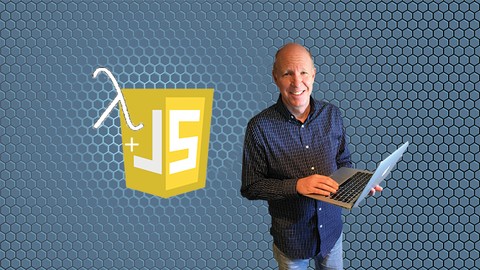
Functional Programming in JavaScript: A Practical Approach
Functional Programming in JavaScript: A Practical Approach, available at $79.99, has an average rating of 4.58, with 50 lectures, based on 675 reviews, and has 5547 subscribers.
You will learn about Functional programming techniques you can apply right now. Concepts that define a functional programming approach. The difference between an OOP approach and a functional approach in JavaScript. JavaScript libraries such a Lodash and Ramda that support a functional approach. Techniques such as currying, cloning and composition done using vanilla JavaScript. JavaScript concepts critical to understanding functional programming. Creating pure functions that avoid mutations and side effects. Declarative programming. Avoiding shared state and mutations. This course is ideal for individuals who are JavaScript developers that want to learn functional programming techniques and concepts. It is particularly useful for JavaScript developers that want to learn functional programming techniques and concepts.
Enroll now: Functional Programming in JavaScript: A Practical Approach
Summary
Title: Functional Programming in JavaScript: A Practical Approach
Price: $79.99
Average Rating: 4.58
Number of Lectures: 50
Number of Published Lectures: 50
Number of Curriculum Items: 50
Number of Published Curriculum Objects: 50
Original Price: $94.99
Quality Status: approved
Status: Live
What You Will Learn
- Functional programming techniques you can apply right now.
- Concepts that define a functional programming approach.
- The difference between an OOP approach and a functional approach in JavaScript.
- JavaScript libraries such a Lodash and Ramda that support a functional approach.
- Techniques such as currying, cloning and composition done using vanilla JavaScript.
- JavaScript concepts critical to understanding functional programming.
- Creating pure functions that avoid mutations and side effects.
- Declarative programming.
- Avoiding shared state and mutations.
Who Should Attend
- JavaScript developers that want to learn functional programming techniques and concepts.
Target Audiences
- JavaScript developers that want to learn functional programming techniques and concepts.
Are you wanting to learn how to apply functional programming in JavaScript? Have the concepts been a bit difficult to grasp? Are you not quite sure how functional programming differs from other approaches used in JavaScript? If so, this course is for you!
The functional programming paradigm was difficult, at first, for me to grasp and implement. Therefore, I wanted to create a course that would help others make the leap and begin applying functional programming techniques into their own code. In this course you will learn techniques that you can apply today. But remember, you don’t need to implement everything immediately. Implement those things that make sense and grow into it slowly.
In this course I have taken the approach of dissecting a technical definition of functional programming and using that definition as the structure of the course. We will break it down into pieces. Focus on those pieces and the techniques you can use right away. Each new concept will build on the previous concepts. And in the end you will see all the concepts come together.
If you learn by doing, this course gives you plenty of chances to work on exercises and then sit back and watch as I go through the exercise. By doing and then watching my approach, you will learn how to apply functional programming concepts to JavaScript.
Jump in today and begin learning a different way of using JavaScript!
Course Curriculum
Chapter 1: Course Introduction
Lecture 1: Introduction
Lecture 2: Making the Most of this Course
Chapter 2: Introduction to Functional Programming
Lecture 1: Introducing Functional Programming
Chapter 3: Side Effects and Pure Functions
Lecture 1: Avoiding Side Effects and Using Pure Functions
Lecture 2: Exercise 1 Start
Lecture 3: Exercise 1 Finish
Lecture 4: Exercise 1 Follow Up: Other Possible Solutions and the Problems
Lecture 5: Exercise 1 Follow Up: Using the Array.find Method.
Chapter 4: Avoiding Shared State and Mutations
Lecture 1: Avoiding Shared State
Lecture 2: Avoiding Mutations
Lecture 3: Cloning Objects
Lecture 4: Using the spread Operator for Shallow Cloning
Lecture 5: Exercise 2 Start
Lecture 6: Exercise 2 Finish
Lecture 7: Using Reduce, Map and Filter
Lecture 8: Exercise 3 Start
Lecture 9: Exercise 3 Finish
Lecture 10: Exercise 4 Start
Lecture 11: Exercise 4 Finish
Lecture 12: Exercise 4 Follow Up
Chapter 5: Function Composition
Lecture 1: JavaScript Concepts Review: First Class and Higher Order Functions, Closure
Lecture 2: Function Composition Part 1
Lecture 3: Arrow Functions
Lecture 4: Exercise 5 Start
Lecture 5: Exercise 5 Finish
Lecture 6: Function Composition Part 2
Lecture 7: Exercise 6 Start
Lecture 8: Exercise 6 Finish
Lecture 9: Understanding Arity
Lecture 10: JavaScript Concepts for Understanding Currying
Lecture 11: Deep Dive into Currying
Lecture 12: Dissecting the Curry Function
Lecture 13: Exercise 7 Start
Lecture 14: Exercise 7 Finish
Chapter 6: Understanding Declarative Programming
Lecture 1: Imperative versus Declarative Programming
Lecture 2: Exercise on Declarative Programming Start
Lecture 3: Exercise on Declarative Programming Finish
Chapter 7: Functional Programming Example: Comparing OOP to Functional
Lecture 1: Functional Programming Example
Lecture 2: Example Follow Up
Chapter 8: Lodash
Lecture 1: Using the Lodash JavaScript Library
Lecture 2: Exercise 8 Start
Lecture 3: Exercise 8 Finish
Chapter 9: Ramda
Lecture 1: Using the Ramda JavaScript Library
Lecture 2: Exercise 9 Start
Lecture 3: Exercise 9 Finish
Chapter 10: Other Functional Techniques and Articles
Lecture 1: Understanding Recursion
Lecture 2: Recursion Take 2
Lecture 3: Additional Articles
Chapter 11: Congratulations
Lecture 1: Congratulations
Lecture 2: BONUS Lecture! Discounts on Other Courses
Instructors
-
Steven Hancock
Owner All Things JavaScript
Rating Distribution
- 1 stars: 6 votes
- 2 stars: 14 votes
- 3 stars: 73 votes
- 4 stars: 251 votes
- 5 stars: 331 votes
Frequently Asked Questions
How long do I have access to the course materials?
You can view and review the lecture materials indefinitely, like an on-demand channel.
Can I take my courses with me wherever I go?
Definitely! If you have an internet connection, courses on Udemy are available on any device at any time. If you don’t have an internet connection, some instructors also let their students download course lectures. That’s up to the instructor though, so make sure you get on their good side!
You may also like
- Best Video Editing Courses to Learn in March 2025
- Best Music Production Courses to Learn in March 2025
- Best Animation Courses to Learn in March 2025
- Best Digital Illustration Courses to Learn in March 2025
- Best Renewable Energy Courses to Learn in March 2025
- Best Sustainable Living Courses to Learn in March 2025
- Best Ethical AI Courses to Learn in March 2025
- Best Cybersecurity Fundamentals Courses to Learn in March 2025
- Best Smart Home Technology Courses to Learn in March 2025
- Best Holistic Health Courses to Learn in March 2025
- Best Nutrition And Diet Planning Courses to Learn in March 2025
- Best Yoga Instruction Courses to Learn in March 2025
- Best Stress Management Courses to Learn in March 2025
- Best Mindfulness Meditation Courses to Learn in March 2025
- Best Life Coaching Courses to Learn in March 2025
- Best Career Development Courses to Learn in March 2025
- Best Relationship Building Courses to Learn in March 2025
- Best Parenting Skills Courses to Learn in March 2025
- Best Home Improvement Courses to Learn in March 2025
- Best Gardening Courses to Learn in March 2025






















